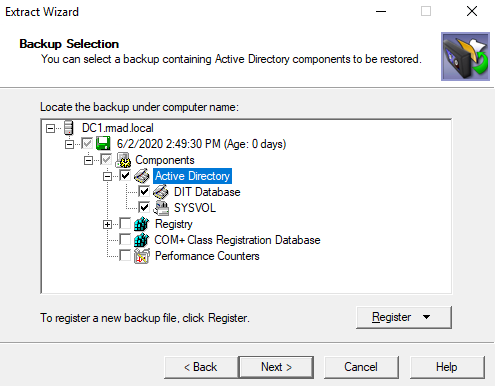Authoritative restore
In this section:
DIT database
With the Repair Wizard, you can perform an authoritative restore of Active Directory. The wizard allows you to mark the entire Active Directory database, a single subtree, or an individual object as authoritatively restored.
To mark AD objects, subtree, or the entire AD database as authoritative, Recovery Manager for Active Directory uses the capabilities provided by the Ntdsutil.exe tool supplied with Microsoft Windows. However, this tool included in Windows Server 2008 or higher does not support marking the entire AD database as authoritative.
As a result, the wizard increments the version number of the attributes of all objects in the entire directory, all objects in the subtree, or the particular object to make it authoritative for the directory.
An authoritative restore can only be carried out on objects from the configuration and domain naming contexts. Authoritative restore of the schema-naming context is not supported.
SYSVOL
When performing an authoritative restore of the Active Directory database, you should also perform an authoritative restore of the SYSVOL. With the Repair Wizard, the authoritative restore of the SYSVOL does not occur automatically. To do that, you should follow the procedure outlined in the next section.
By restoring the SYSVOL authoritatively, you specify that the restored copy of SYSVOL is authoritative for the domain. As a result, the replication service replicates the local SYSVOL out to the other domain controllers within the domain.
The bandwidth associated with such replication should be considered in case of an extensive use of large Group Policy objects and logon scripts in the domain.
Since the Online Restore Wizard and Group Policy Restore Wizard allow you to authoritatively restore directory data with minimal effort and overhead, we recommend you to use those wizards rather than the Repair Wizard when you need to recover/undelete individual Active Directory objects and Group Policy objects.
Restoring SYSVOL authoritatively
When you have performed an authoritative restore of Active Directory using the Repair Wizard, additional steps must be taken to restore the SYSVOL authoritatively. By doing this, you are telling the other domain controllers in the domain that the SYSVOL information on the restored domain controller is authoritative. As a result, the files and folders contained under SYSVOL on the restored domain controller are replicated out to all other domain controllers in the domain.
To restore SYSVOL authoritatively
-
Use the Repair Wizard to restore Active Directory on the target domain controller.
-
After the Repair Wizard completes the restore, start the Extract Wizard.
-
Follow the instructions in the Extract Wizard.
-
On the Backup Selection page, select the SYSVOL component of the backup you want to use. The SYSVOL component is located in the Active Directory branch of the backup:
-
On the Folder Selection page, specify the folder for the SYSVOL data.
-
Follow the Extract Wizard to restore the SYSVOL data from the backup to the specified folder.
-
After the Extract Wizard is completed, ensure that the domain controller where you want to authoritatively restore SYSVOL is started in normal mode and the SYSVOL share is published, that is, the SYSVOL shared folder and its sub-folders are displayed in Computer Management for that domain controller.
-
Copy the restored by the Extract Wizard SYSVOL folder over the original SYSVOL folder.
When authoritatively restoring the SYSVOL, it is important that you copy SYSVOL data from the alternate location after the SYSVOL share is published.
If the computer is in a replicated domain, it can take several minutes before the SYSVOL share is published, because it needs to synchronize with its replication partners.
If there is no other functioning domain controller in the domain, a primary restore of the SYSVOL should be done. When restoring the SYSVOL, the Repair Wizard allows you to mark the SYSVOL for primary restore. A primary restore builds a new replication service database by loading the data present under SYSVOL on the local domain controller.
Given that each Group Policy object is comprised of the Group Policy Container and Group Policy Template, when a Group Policy Container is authoritatively restored by using the Repair Wizard or Online Restore Wizard, the corresponding Group Policy Template must then be authoritatively restored as part of the SYSVOL. Since selective restoration of the SYSVOL data is time-consuming and requires considerable expertise, we recommend that restoration of Group Policy objects be performed by using the Group Policy Restore Wizard, which authoritatively restores both Group Policy Containers and Group Policy Templates, and ensures that Group Policy objects are properly restored with minimal administrative overhead.

